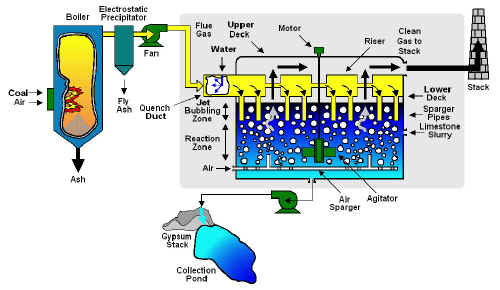
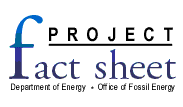 |
Demonstration of Innovative Applications of Technology for the CT-121 FGD ProcessEnvironmental Control
Devices
|
|
| |
|
Participant Location Plant Capacity/Production Coals Compliance, 1.2% sulfur Technology |
|
Additional Team Members | |||||||
| |||||||||
|
Jet Bubbling Reactor is a registered trademark of the Chiyoda Corporation. | |||||||||
 Project Objective
Project Objective
To demonstrate 90% SO2 control at high reliability with and without simultaneous particulate control; to evaluate use of fiberglass-reinforced-plastic (FRP) vessels to eliminate flue gas reheat and spare absorber modules; and to evaluate use of gypsum to reduce waste management costs.
Technology/Project Description
The project demonstrated the CT-121 FGD process, which uses a unique absorber design known as the Jet Bubbling Reactor® (JBR). The process combines limestone FGD reaction, forced oxidation, and gypsum crystallization in one process vessel. The process is mechanically and chemically simpler than conventional FGD processes and can be expected to exhibit lower cost characteristics.
The flue gas enters underneath the scrubbing solution in the Jet Bubbling Reactor® . The SO2 in the flue gas is absorbed and forms calcium sulfite (CaSO3 ). Air is bubbled into the bottom of the solution to oxidize the calcium sulfite to form gypsum. The slurry is dewatered in a gypsum stack, which involves filling a dyked area with gypsum slurry. Gypsum solids settle in the dyked area by gravity, and clear water flows to a retention pond. The clear water from the pond is returned to the process.
Results Summary
Environmental
-
Over 90% SO2 removal efficiency was achieved at SO2 inlet concentrations of 1,000-3,500 ppm with limestone utilization over 97%.
-
JBR achieved particulate removal efficiencies of 97.7-99.3% for inlet mass loadings of 0.303-1.392 lb/106 Btu over a load range of 50-100 MWe.
-
Capture efficiency was a function of particle size:
|
-
Hazardous air pollutant (HAP) testing showed greater than 95% capture of hydrogen chloride (HCl) and hydrogen fluoride (HF) gases, 80-98% capture of most trace metals, less than 50% capture of mercury and cadmium, and less than 70% capture of selenium.
-
Gypsum stacking proved effective for producing wallboard/cement-grade gypsum.
Operational
-
FRP-fabricated equipment proved durable both structurally and chemically, eliminating the need for a flue gas prescrubber and reheat.
-
FRP construction combined with simplicity of design resulted in 97% availability at low ash loadings and 95% at high ash loadings, precluding the need for a spare reactor module.
-
Simultaneous SO2 and particulate control were achieved at flyash loadings reflective of an ESP with marginal performance.
Economic
-
Final results are not yet available. However, elimination of the need for flue gas prescrubbing, reheat, and spare module requirement should result in capital requirements far below those of conventional FGD systems.
Project Summary
The CT-121 process differs from the more common spray tower type of flue gas desulfurization systems in that a single process vessel is used in place of the usual spray tower/reaction tank/thickener arrangement. Pumping of reacted slurry to a gypsum transfer tank is intermittent. This allows crystal growth to proceed essentially uninterrupted resulting in large, easily dewatered gypsum crystals (conventional systems employ large centrifugal pumps to move reacted slurry causing crystal attrition and secondary nucleation).
| |||||||||||||||||||||||||||||||||||||||||||||||||||||||||||||||||||||||||||||
The demonstration spanned 27 months, including start-up and shakedown, during which approximately 19,000 hours were logged. Exhibit 10 summarizes operating statistics. Elevated particulate loading included a short test with the electrostatic precipitator (ESP) completely deenergized, but the long-term testing was conducted with the ESP partially deenergized to simulate a more realistic scenario, i. e., a CT-121 retrofit to a boiler with a marginally performing particulate collection device. The SO2 removal efficiency was measured under five different inlet concentrations with coals averaging 2.4% and ranging 1.2-4.3% sulfur (as burned).
Operational Performance
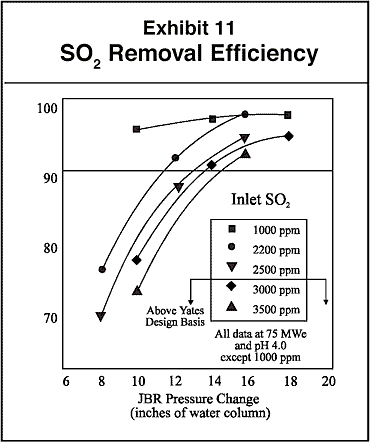 |
Use of FRP construction proved very successful. Because their large size precluded shipment, the JBR and limestone slurry storage tanks were constructed on site. Except for some erosion experienced at the JBR inlet transition duct, the FRP-fabricated equipment proved to be durable both structurally and chemically. Because of the high corrosion resistance, the need for a flue gas prescrubber to remove chlorides was eliminated. Similarly, the FRP-constructed chimney proved resistant to the corrosive condensates in wet flue gas, precluding the need for flue gas reheat.
Availability of the CT-121 scrubber during the low-ash test phase was 97%. It dropped to 95% under the elevated ash-loading conditions due largely to sparger tube plugging problems precipitated by flyash agglomeration on the sparger tube walls during high ash loading when the ESP was deenergized. The high reliability demonstrated verified that a spare JBR is not required in a commercial design offering.
Environmental Performance
Exhibit 11 shows SO2 removal efficiency as a function of pressure drop across the JBR for five different inlet concentrations. The greater the pressure drop, the greater the depth of slurry traversed by the flue gas. As the SO2 concentration increased, removal efficiency decreased, but adjustments in JBR fluid level could maintain the efficiency above 90% and, at lower SO2 concentration levels, above 98%. Limestone utilization remained above 97% throughout the demonstration.
Long-term particulate capture performance was tested with a partially deenergized ESP (approximately 90% efficiency) and is summarized in Exhibit 12.
Analysis indicated that a large percentage of the outlet particulate matter is sulfate, likely a result of acid mist and gypsum carryover. This reduces the estimate of ash mass loading at the outlet to approximately 70% of the measured outlet particulates.
For particulate sizes greater than 10 microns, capture efficiency was consistently greater than 99%. In the 1-10-micron range, capture efficiency was over 90%. Between 0.5 and 1 micron, the particulate removal dropped at times to negligible values possibly due to acid mist carryover entraining particulates in this size range. Below 0.5 micron, the capture efficiency increased to over 90%. Calculated HAP removals across the CT-121 JBR, based on the measurements taken during the demonstration, are shown in Exhibit 13.
| ||||||||||||||||||||||||||||||||||||||||
As to solids handling, the gypsum stacking method proved effective in the long term. Although chloride content was initially high in the stack due to the closed loop nature of the process (with concentrations often exceeding 35,000 ppm), a year later the chloride concentration in the gypsum dropped to less than 50 ppm, suitable for wallboard and cement applications. The predominant cause of the initial high chloride content was attributed to rainwater washing the stack.
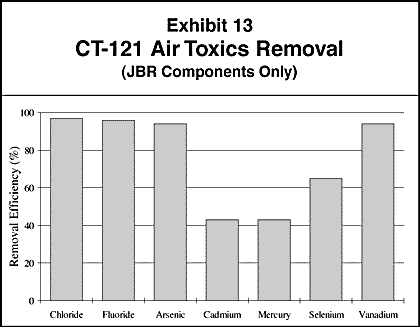 |
Economic Performance
Although the final economic analyses are not yet available, it appears as though CT-121 technology offers significant economic advantages. FRP construction eliminates the need for prescrubbing and reheating flue gas. High system availability eliminates the need for a spare absorber module. Particulate removal capability precludes the need for expensive (capital-intensive) ESP upgrades to meet increasingly tough environmental regulations.
Commercial Applications
Involvement of Southern Company (which owns Southern Company Services, Inc.), with more than 20,000 MWe of coal-fired generating capacity, is expected to enhance confidence in the CT-121 process among other large high-sulfur-coal boiler users. This process will be applicable to 370,000 MWe of new and existing generating capacity by the year 2010. A 90% reduction in SO2 emissions from only the retrofit portion of this capacity represents more than 10,500,000 tons/yr of potential SO2 control.
Plant Yates continues to operate with the CT-121 scrubber as an integral part of the site's CAAA compliance strategy. Since the CCT Program demonstration, over 8,200 MWe equivalent of CT-121 FGD Capacity has been sold to 16 customers in seven countries.
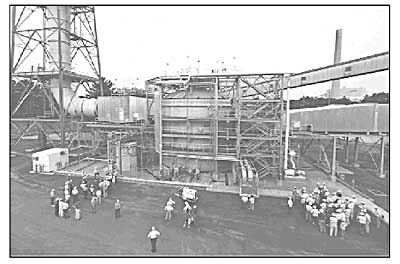 |
|
The unique Jet Bubbling Reactor® (center) was constructed from fiberglass-reinforced plastic. |
The project received Power magazine's 1994 Powerplant Award. Other awards include the Society of Plastics Industries' 1995 Design Award for the mist eliminator, the Georgia Chapter of the Air and Waste Management Association's 1994 Outstanding Achievement Award, and the Georgia Chamber of Commerce's 1993 Environmental Award.
Contacts
David P. Burford, Project Manager
Southern Company Services,
Inc.
42 Inverness Parkway, Suite 340
Birmingham, AL 35242
(205)
992-6329
(205) 992-7535 (fax)
dpburfor@southernco.com
Lawrence Saroff, DOE/HQ, (301) 903-9483mailto:%20lawrence.saroff@hq.doe.gov
James U. Watts, DOE/NETL, (412) 386-5991 mailto:watts@fetc.doe.gov

